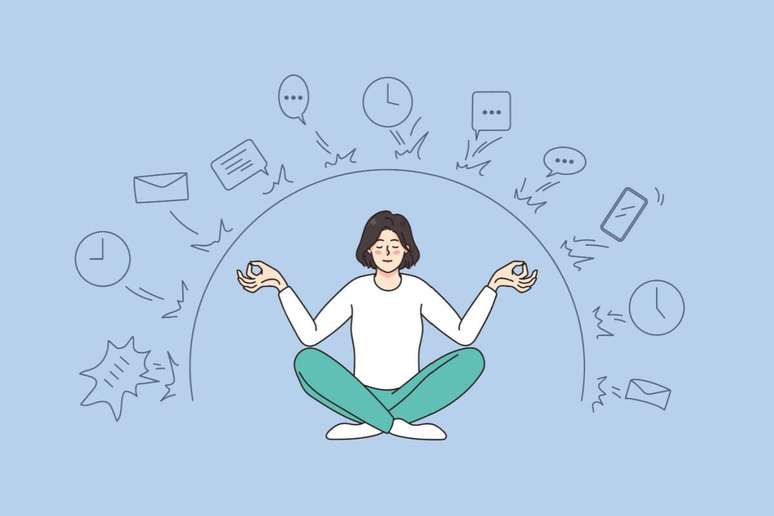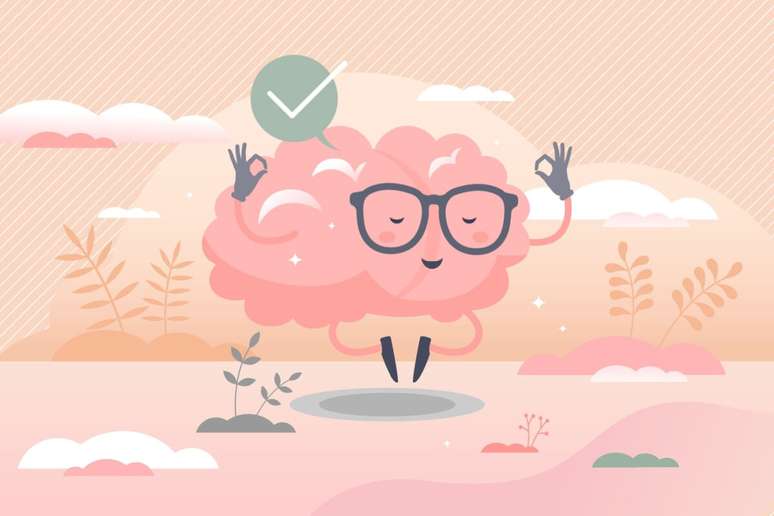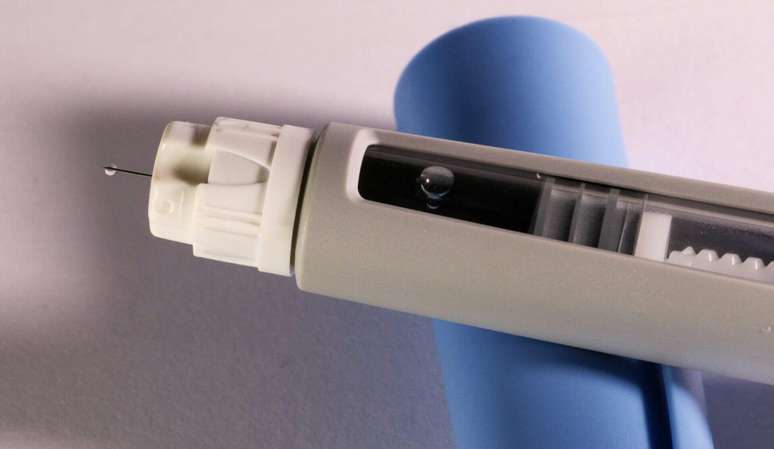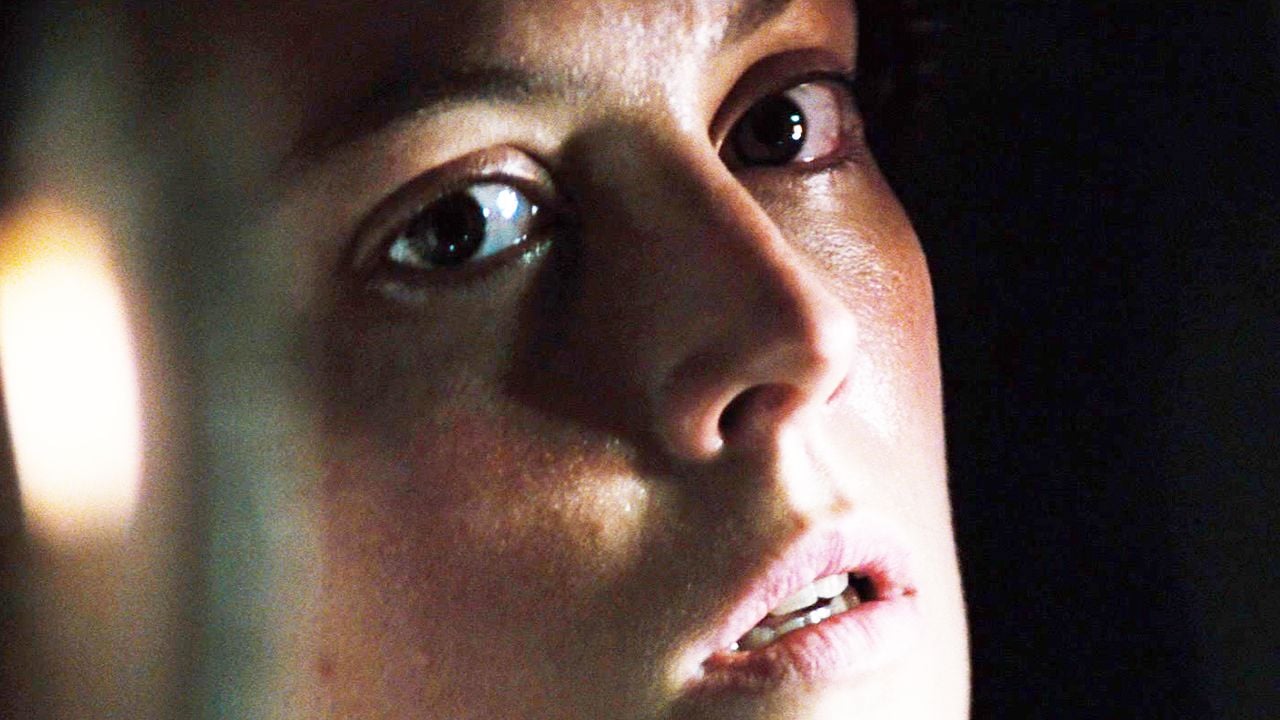When we reduce mental activity, we land in the present moment, allow intuition, and let feelings be free to express themselves.
Every day, when the afternoon fades and night begins to dawn, I take a few moments to meditate. I stop what I’m doing, light a candle, put the phone on night mode and, with headphones in my ear, I am guided to keep my spine straight, my arms limp on my knees, the air entering through my nose and out of my mouth. Guided practice is an invitation to root myself in the present. I welcome you and thank you for the day, for the beautiful things and also for the less beautiful ones. I establish a connection with myself and my surroundings.
By speaking this way, it may seem easy for me to immerse myself in the present. In fact, I have always found meditation difficult. Because it requires concentration, dedication and, above all, concentration for thoughts to reduce their frequency, putting the mind in a place of rest.
It’s just that I I think too muchin everything and at the same time. The next thing I know, I went from one point to another in a matter of seconds, creating several obstacles along the way. At the beginning of my meditation practice, unconsciously, I wove in my mind a journey full of doubts and questions: “But what happens if I don’t breathe in the right way? What if the doorbell rings and I have to open the door? I haven’t finished that text, but perhaps this and that sentence are a good means”.
So when I came back on the air, the meditation audio was over and I hadn’t even paid attention to it. Today, almost seven months later, this still happens sometimes. However, with consistency, I am able to get back on track and ground myself in a more natural way.
Over thinking
Sometimes, overthinking feels like a balloon filled with helium gas. If we don’t hold it firmly by the rope, it takes flight and disappears forever in the clouds. “Thinking too much can be a creation of strategies, a way to ensure you make the best decisions, obtaining positive results, a way to seek guarantees that avoid mistakes,” explains clinical psychologist Andréia Rodrigues.
According to her, the prevalence of the rational can protect us, but also shorten our actions. To the point of paralyzing us in the idealization of possible scenarios that may not even materialize. Those “what ifs”, you know? We cannot predict or control everything around us.
In most cases, the only thing we can do is simply live, patiently, one day at a time, even if it’s difficult. “THE over thinking It can deprive us of good experiences, of more spontaneous actions, of getting more in touch with our feelings”, adds Andréia.
It also reminds us that thinking too much makes you ill, leading, among many consequences, to that emotion that many of us already know well: anxiety. “In these cases, the flow of thoughts tends to be high and fast, generating worries, anguish and even physical symptoms,” he underlines.
Internal acceleration increases anxiety and interferes with mental and physical health, reducing quality of life. And that’s not what we want, right? How, then, can we dismantle the vortex that rages in our heads, in order to follow a lighter, healthier and more spontaneous path?
Don’t get entangled
It would be great if there were a switch to turn the ultra-thinking brain on and off, like the light bulbs in our house. However, since this convenience does not exist, we must look for alternatives that help us relax a little in the face of the frenzy of life.
Karen Vogel is also a psychologist, professor at The School of Life and author of the book Observe thoughts (Conscientia), on awareness. And he tells me that, in mindfulness practices, the ideal is not to try to reduce the mental flow, but to observe it without believing that it always tells the truth.
“At every moment, different thoughts are produced over which we have no control. The big question is when we identify with them. This changes our inner world, since that content produced by the mind also brings us different sensations,” he explains.
Notice how liberating it is: our thoughts only have strength if we “buy” the stories they tell. “We must learn to distance ourselves from the mind in order to use it as a tool for our evolution”, emphasizes Karen.
He explains that practicing exercises in which we focus on breathing or bring our attention to bodily sensationsfor example, it helps a lot to “catch our mind in the jump”, when it works by producing unwanted, excessive content that causes suffering.

How to balance rationality
Of course, reason has immense value in our lives, as long as it does not eclipse other aspects of being. “It is possible to learn to balance rationality through the development of other alternative and very important functions, such as feeling and intuition.”
Meditation practices, physical activityOperations that give pleasure and that do not involve reasoning also help, such as contemplating a sunset or a landscape. “The ‘just for today I won’t solve any problems, I’ll just live’ is another interesting exercise,” Karen points out.
You see, it’s not about adopting a controlling attitude, typical of those who think a lot. But rather, acquire the waking habit of drawing us into reality every time a thought dares to distract us from it.
“Treating thoughts as an absolute truth is something that must be looked at with care and compassion. Just because I am thinking about something does not necessarily mean that it is reliable. Developing these perspectives are invitations to a lighter life and deidentified from mental formulations,” point.
Needle shuttle
It is clear that by learning to recognize and distinguish the quality of our thoughts, we will be able to experience a more peaceful life, with less rumination and complaints. Now evaluate the benefits. “Thinking less improves the executive function of the prefrontal cortex, resulting in increased concentration and attention; influences the quality of sleep; improves the ability to be present in social interactions, promoting deeper and more meaningful connections with people,” Karen summarizes .
And it doesn’t end there: he also says that, at the same time, give space to the rationalthey increase the chances of making connections with the present moment and strengthening resilience, “as we are more in touch with pure emotion and not with judgmental thoughts about it”.
Fernanda Cecília found in embroidery a way to reduce mental activity. The impetus of the synapses gradually gives way to affection, affection, the restoration of memories and reflections that are as slow as they are elaborate. She always enjoyed writing in journals and diaries, even in friends’ notebooks.
There he wove thoughts, verses and letters, but as time passed he lost this habit. The resumption of this activity took place about seven years ago, through embroidered words. “I discovered in this coming and going of the needle, in this coloring with lines, a possibility of active meditation”, he explains.

Calm the mind
In many moments of anxiety, with her head overwhelmed, Fernanda embroidered what she felt needed to access among her emotions. “When I embroider what I feel I need or want for myself and the world, I call it embroidering with intention.”
Calm, one day at a time, peace, love, hope, gratitude, lightness, slowing down: these are just some of the intentions that he has already embroidered and shared on his profile @entrelinhas_fc. “Embroidering freely, without pressure of any kind, by will, or even by necessity, knowing the benefits, helps to calm the mind and calm the heart”, he guarantees, sowing in us the desire to put our hands to work without obligations.
Each of us, in our daily activities, can find a way to slow down and think less, lightening the internal weight of what is good for us and calms our chest. “We need to rethink the way we live. With so much accelerated stimulus, the hours pass and we are barely present in the present,” Andréia points out.
And this, according to her, lies in the private, in the small pleasures that are experienced in everyday life, like having tea with a friend, without checking messages or social media. Furthermore, a routine of exercise, good eating habits, quality sleep, self-care, emotional management, hobbies, spirituality and faith are not only clear your mind how it gives us back the meaning and satisfaction of being complete in what life brings in each moment. How precious this way of perceiving and protecting oneself is for the body and soul!
“With poetic license, as our late writer Ana Jácomo wrote: ‘Fullness is when life fits into the present moment, without being cramped, and we enjoy the comfort of not missing anything,’” recalls Andréia. Let’s find the lightness we deserve, sowing in our minds what comes to our aid.
By Débora Gomes – Vida Simples magazine
A journalist, he lives on the thread of his thoughts, but from them he has learned that one day at a time is the best way to live together well. It’s worked so far.
Source: Terra
Ben Stock is a lifestyle journalist and author at Gossipify. He writes about topics such as health, wellness, travel, food and home decor. He provides practical advice and inspiration to improve well-being, keeps readers up to date with latest lifestyle news and trends, known for his engaging writing style, in-depth analysis and unique perspectives.







![Such a wonderful sun in advance: Summary of the episode on August 21, 2025 [SPOILERS] Such a wonderful sun in advance: Summary of the episode on August 21, 2025 [SPOILERS]](https://fr.web.img5.acsta.net/img/d3/05/d305bc2e988868b047486aa1f425d806.jpg)
